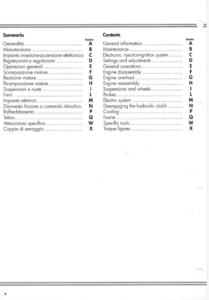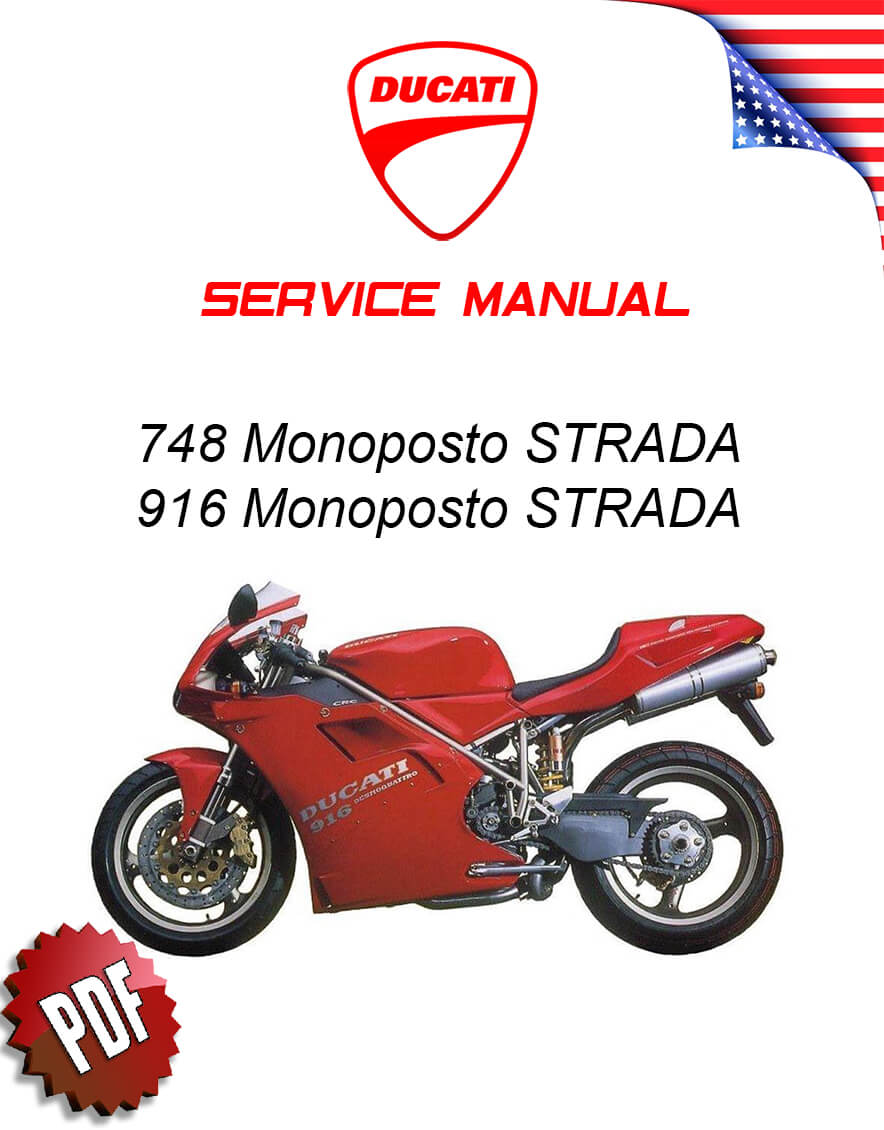Complete PDF version of the Service Manual for the Ducati 748/916. A MUST for every 748/916 owner.
Download: Immediately after payment!
OEM Original factory workshop manual.
Models covered by this manual: 1994 to 2002
Number of pages: 484 pages
Table of contents:

This PDF repair manual can be downloaded right after the payment process in complete, on the device of your choice.
We do not offer printed manuals, for the following reasons:
- it is more eco-friendly to use a digital version
- your manual never gets dirty or greasy
- you can always choose to print the specific page(s) you need to work on your bike
- you receive your manual immediately after payment
- it is searchable
Ducati 748/916
The Ducati 748 was a sport bike produced by Ducati from 1994 to 2002. The 748 was a smaller variant of the 916 that was superseded by the 749 in 2003.
The Ducati 916 is a full-faired sport bike produced by Ducati between 1994 and 1998. The 916 is generally considered as one of the most beautiful bikes ever, with a 916 cc (56 cu in) fuel injected, 4-valve, desmo, liquid-cooled, 90° V-twin engine in a trellis frame with a single-sided swing-arm and USD forks.
748
The Ducati Desmoquattro engine began as a 748 cc (45.6 cu in) displacement engine with cylinder heads designed for a narrower bore than the 916, therefore a smaller version of the 916 was to be expected.
The Ducati 748 is nearly similar to the Ducati 916, both of which were designed by Ducati in-house designer Massimo Tamburini and share certain design aspects with the Ducati Supermono. The main variations are the rear tyre size (180/55/17 as opposed to 190/50/17) and engine capacity (748 cc) (88 mm diameter and 61.5 mm stroke) (45.6 cu in). The engine’s shorter piston stroke allows for a higher rev maximum of 11500 RPM, while the smaller pistons allow the engine to accelerate faster.
Ducati developed many versions of the 748, beginning with the base 748 Biposto (meaning “two seat”) in 1994, followed by the 1995–96 748SP and 1996–99 748SPS as more powerful choices. The many engine versions (each weighing close to 54 kilograms (119 lb)) generated at least 71 kilowatts (95 hp). The SP and SPS engines were fine-tuned and only available as monoposto (meaning “single seat”), but the standard 748 could be ordered with a monoposto option, and were designed as homologation bikes for World Supersport racing. Over and above the standard model, Ohlins rear shocks and completely floating cast-iron Brembo brake disks were supplied. The engines also had an oil cooler.
Ducati updated their 748 model range in 2000 to offer a third variant. The base model was now known as the 748E, and it was offered in Biposto or Monoposto configurations, with 3-spoke gold wheels and a gold frame. The quick-release Dzus fasteners on the fairing had been replaced with simple fairing fasteners, and the frame had a set steering head angle. The Sachs-Boge rear shock was paired with Showa forks. This assisted in keeping prices down.
The 748S served as the intermediate model. This had lighter grey 5-spoke Marchesini wheels to match the grey frame, as well as the earlier adjustable steering head. The rear shock was now a Showa unit, with Showa forks up front, with Titanium-Nitride (TiN) coating on the fork stanchions to “avoid stiction,” which also gave it a gold hue. The engine was identical to that of the 748E.
The 748R, Ducati’s racing homologation variant built in extremely limited quantities, was now the top of the line model. This engine was a variation on the SPS concept, but with additional tweaking. The key difference is that the R model features an overhead shower-injector configuration as opposed to the typical throttle bodies, titanium connecting rods, titanium valves, and more severe valve timing seen in the 748E and S models.
As a result, the 748R features a bigger, two-part airbox, and the frame was modified to suit this. Although the suspension was Ohlins for both the rear shock and the front forks, the very first versions in 2000 featured Showa titanium nitride (TiN) front forks and a Showa shock absorber. The engine incorporated a simple slipper clutch to guarantee that it could be homologated for racing purposes, as well as an oil cooler.
Ducati also created a very limited run (less than 20) of 748RS motorcycles, which were designed as full racing machines and came with no road-going equipment (lights, odometer, mirrors). The engine internals and components were drastically different from any other Ducati on the road, made of a mix of light-weight, high-strength materials that made them extraordinarily expensive to buy, run, and repair. The RS had a 54 mm exhaust system and a slightly reduced size and gauge of Chromoly tubing on the frame to help save weight.
Ducati also created the limited edition 748S Senna in 2002, which employed the same components as the 748S but had a flat grey body, a grey frame, and red Marchesini 5 spoke wheels. It was exclusively available in Monoposto.
916
The 916 model family’s origins may be traced back to the invention of the four-valve Ducati engine, the Desmoquattro, via the development and racing of older Pantah models, through the road-going 851 and 888 models.
Fabio Taglioni (1920–2001), who launched the Pantah in 1979, has been the head designer of Ducati bikes since the 1970s. The engine was modified in the 1990s as part of the SuperSport (SS) series, and all present Ducati engines are descendants of the Pantah, which employed camshafts to open and shut the engine’s valves, eliminating the typical valve closing springs, a technology known as ‘desmodromic.’ Taglioni, on the other hand, had little interest in four-valve head engines, therefore this was left to his successor. Massimo Bordi, Taglioni’s successor, designed the eight-valve V-twin.
The 916’s water-cooled engine, designed by Massimo Tamburini and Sergio Robbiano and his team at the Cagiva Research Centre in San Marino, was a refinement of that of its predecessor, the 888, with bigger displacement and a new engine management system. The increased displacement was achieved by raising the crankshaft stroke from 64 mm to 66 mm while maintaining the same 94 mm bore size as the 888, resulting in a capacity of 916 cc. (By the time the 916 was released, the bore diameters of the final 851/888 Corse engines had been raised to 96 mm, resulting in ‘race only’ capacities of 926 cc and 955 cc, respectively.)
The 916 was a smaller motorbike than the 888, with a trellis frame made of chrome-moly that was shared with the Ducati 748 in 1995 and beyond. This was complemented with eye-catching new bodywork with strong lines. Compared to its Japanese inline four-cylinder contemporaries at the time, the V-twin engine generated less raw power but a more uniform torque distribution. In 1999, the 916 model was superseded by the 996 model.
The Ducati 916’s design was a blend of form and function:
- The elegant single-sided swing-arm was created to speed up wheel swaps during races.
- The under-seat exhausts boost aerodynamic performance while also providing exceptionally clean looks. This feature was originally seen on the Honda NR, and while Ducati was not the first to use it, it has become one of the 916 line’s distinguishing characteristics.
According to journalist Kevin Ash, despite being “one of the most influential machines of the last twenty years,” the 916’s design is actually a derivative of the Honda NR750, with shared elements such as an underseat exhaust, a narrow waist, similar squared-off dual headlights, and a single-sided swingarm holding a large-section rear tire.
Source: Wikipedia


